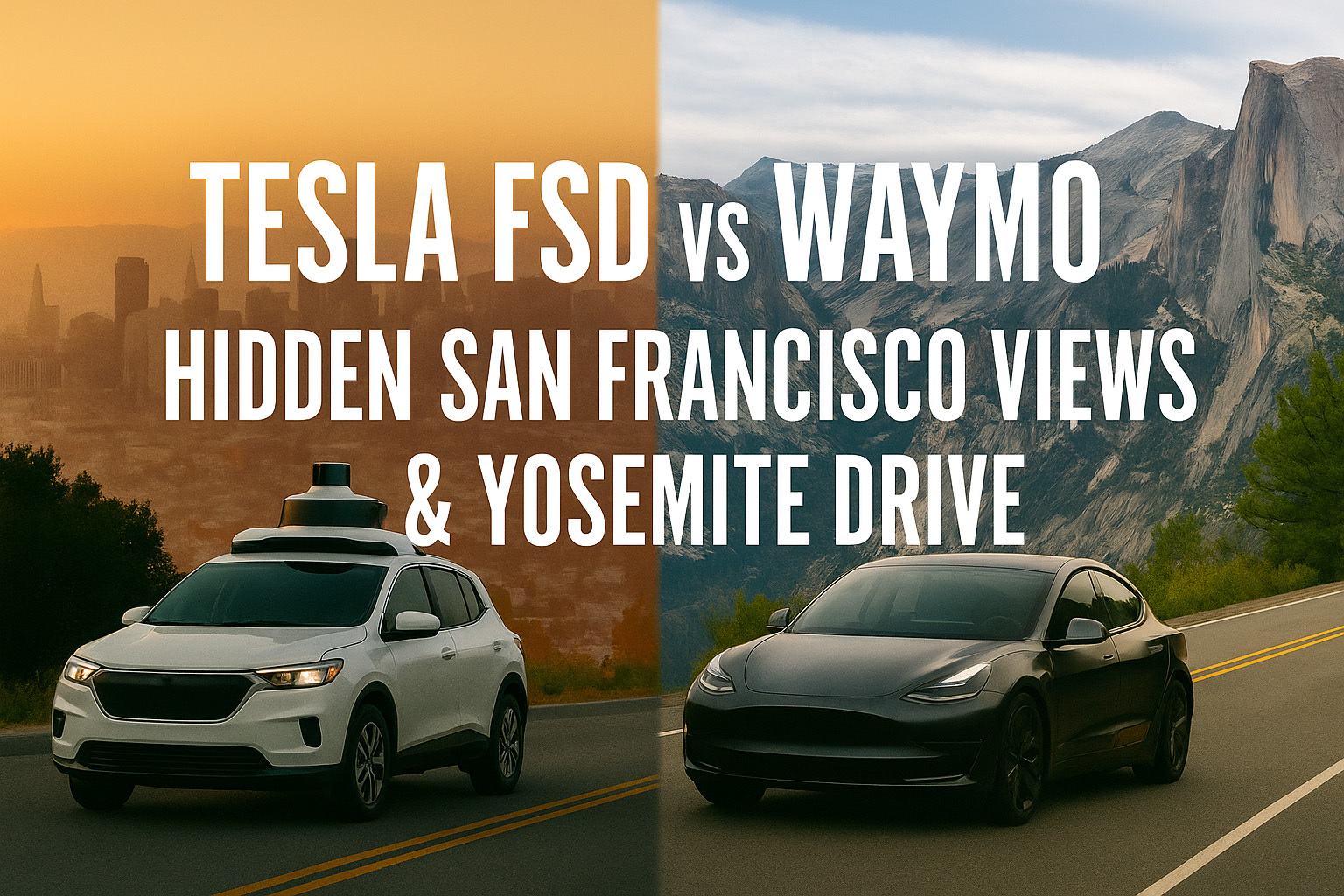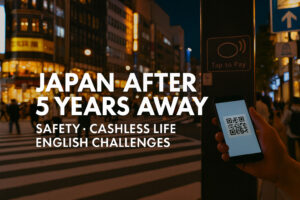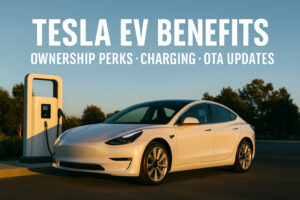Tesla FSD vs Waymo: Hidden San Francisco Views & Yosemite Drive

Crossing California with Tesla FSD: San Francisco → Yosemite Part 2
Introduction
Welcome to Part 2 of our road trip from San Francisco to Yosemite National Park.
In this segment we roll along the I-580 freeway near Oakland, spotlighting Tesla FSD’s technical tricks and uncovering off-the-radar scenic spots.
Look forward to ruins like the Sutro Baths and the rugged Mile Rock Beach—fresh angles that even the guidebooks miss.
*This article condenses the key points from the video below into text form.*
If something sparks your curiosity, be sure to watch the full video!
🛣️ Route Details
- Driving area: I-580 corridor near Oakland
- Main waypoints: San Leandro, toward Fremont
- Highlight: running parallel to BART (Bay Area Rapid Transit)
Tesla FSD vs. Waymo: Two Paths to Autonomy
Key Technical Differences
| Category | Tesla FSD | Waymo |
|---|---|---|
| Sensor suite | Vision-only (cameras) | LiDAR + cameras + radar |
| Operational area | Usable almost anywhere | Limited to pre-mapped zones |
| Autonomy level | Level 2 (driver supervision required) | Level 4 (fully driverless) |
| Cost | Relatively low | High (LiDAR is expensive) |
Tesla CEO Elon Musk famously calls LiDAR a “crutch,” arguing that—just as humans drive safely with eyes and brains alone—an AI trained on camera vision can achieve human-level (or better) performance without the extra sensors.
Technical Highlights of Tesla FSD
📹 FSD Camera Suite
- Cameras: 8 units covering the vehicle in all directions
- Detection range: identifies objects up to roughly 250 m (820 ft) ahead
- What it sees: vehicles, pedestrians, bikes, turn signals, brake lights, lane lines, traffic lights, signs, obstacles, and more
- All-weather capability: works in rain, fog, snow, and at night
- End-to-end approach: AI handles everything—from perception to control—directly from video input
One standout feature is that Tesla FSD doesn’t rely on an internet connection.
Yosemite National Park—our destination—has no streetlights and only patchy service after dark, so it’ll be fascinating to see how FSD performs in true blackout conditions.
Hidden Scenic Spots in San Francisco
Sutro Baths Ruins
A lesser-known gem just a 14-minute drive from the Golden Gate Bridge, these ruins are all that remain of what was, in 1896, the world’s largest public swimming complex.
🏛️ History of Sutro Baths
- Builder: Adolph Sutro (24th Mayor of San Francisco)
- Scale: Seven pools (saltwater & freshwater) holding 1.7 million gallons (~6,400 tons) of seawater
- Admission: $0.10—remarkably cheap for the era
- Reason for closure: Decline after the Great Depression; totally destroyed by fire in 1966
- Today: Visitors can explore the remaining foundations and pool outlines; the site is also famous for ghost stories
An ingenious high-tide system once funneled seawater into the pools, a testament to the engineering prowess of the day. Now you can enjoy both the historic ruins and sweeping Pacific Ocean vistas from this unique spot.
Coastal Trail & Cave Exploration
The area around Sutro Baths features the picturesque Coastal Trail, plus a small cliffside cave you can actually walk through.
Designed by Adolph Sutro as part of the original complex, the passage once helped regulate seawater flow—so you get both ruins and a bit of spelunking in one adventure-packed stop.
⚠️ Tips for your walk: The Coastal Trail includes steep stairs and narrow cliffside paths, so wear sturdy shoes.
Parking near the Golden Gate Bridge fills quickly; consider lots closer to the Coastal Trail instead.
Mile Rock Beach
Descend the Coastal Trail’s steep steps to reach this hidden shore.
Scattered boulders create an otherworldly scene, and the relative lack of crowds means you’ll enjoy rare tranquility.
The surf is rough, making it ill-suited for swimming, but the views are spectacular—and often all yours.
Point Bonita Lighthouse
Perched on the opposite headland from Mile Rock Beach, this lighthouse is reached via a tunnel carved right through the cliff.
It’s usually far less crowded than other Golden Gate attractions, so you can explore at a leisurely pace.
⚠️ Visitor tip: Point Bonita Lighthouse closes early (e.g., 3:20 p.m.) and may shut down in bad weather.
Check onsite signs or the official website for up-to-date hours.
San Francisco’s Coastal Defense Ruins
Scattered around the city are numerous gun batteries built between the 19th and 20th centuries to guard the entrance of the Golden Gate—the strait linking the Pacific Ocean and San Francisco Bay.
Today these former fortifications double as spectacular viewpoints.
Battery Spencer
Perched just north of the Golden Gate Bridge, Battery Spencer is the area’s most famous vista point.
Its strategic construction offers sweeping panoramas that now draw sightseers and photographers eager to capture the bridge and the bay in one stunning shot.
Bay Area Public Transit: BART
While driving the freeway we kept spotting BART—the Bay Area Rapid Transit system.
In service since 1972, this high-speed rail network links San Francisco, Oakland, Berkeley, Fremont, and other cities, making it a cornerstone of local transportation.
🚊 BART Basics
- Total length: roughly 211 km (131 miles)
- Fare system: distance-based (about $2–15)
- Airport access: San Francisco International Airport (SFO), Oakland International Airport (OAK)
- Note: A rail network of this scale is rare around Los Angeles
Tesla Practicality: Cargo Space & Long-Distance Travel
Making the Most of the Frunk (Front Trunk)
One handy Tesla feature is the extra front cargo compartment—known as the frunk—made possible by the absence of an engine.
In a Model 3, the frunk holds 88 liters, while the rear trunk offers a roomy 594 liters.
🧳 Packing tip: Two oversized 80-liter suitcases are a tight squeeze, but one large suitcase plus two carry-ons will fit. There’s also an additional storage well under the trunk floor.
Tesla Semi: All-Electric Commercial Truck
Driving across California’s wide-open spaces really highlights the need for efficient freight transport.
Tesla’s forthcoming Semi—an entirely electric big rig—can cover about 300–500 miles (≈480–800 km) on a single charge and still accelerate from 0–60 mph in roughly 20 seconds, even when hauling a full load (≈40 tons).
Wildlife in California
Encountering wildlife is another highlight of driving long distances through the state.
Near Fremont, for example, you might spot larger animals such as wild turkeys or deer roaming local parks.
⚠️ Interacting with wildlife: Small critters like squirrels may look adorable, but they can carry diseases or parasites—so please don’t touch them.
Larger animals such as deer are easily frightened, so keep a respectful distance to avoid causing stress.
Inside Yosemite National Park you’ll often see signs reading “Speeding Kills Bears,” a reminder that excessive speed can lead to collisions with bears. The campaign underscores California’s active efforts to protect its wildlife.
Highway FSD Performance
Running FSD on the freeway is remarkably smooth: it keeps the car centered without any steering or pedal input from you, and it performs lane changes at exactly the right moment whenever necessary.
The system cuts driver workload in several key ways:
- Automatic lane changes: AI selects the optimal timing using data from multiple cameras
- Speed control: fine-tuned with simple steering-wheel buttons
- Charging planning: automatically recommends nearby Superchargers if you’ll need a top-up before reaching your destination
- Continuous improvement: every software update adds new capabilities
Thanks to FSD’s end-to-end architecture, the AI now handles everything—from interpreting camera feeds to making decisions and executing control inputs—bringing the driving feel closer than ever to natural, human-like behavior.
San Leandro: A Residential City in the Bay Area
We’re now cruising through San Leandro, a bedroom community that has grown thanks to more affordable rents compared with San Francisco or Oakland.
Many commuters live here, giving the area a quiet, family-friendly feel and scenery that blends suburban life with touches of nature.
Recap: Hidden Gems Meet High Tech
In Part 2 of our journey from San Francisco to Yosemite, we explored both the nuts and bolts of Tesla FSD and a lineup of off-the-radar scenic spots.
From the historic Sutro Baths ruins to the serenity of Mile Rock Beach and the sense of adventure at Point Bonita Lighthouse, San Francisco offers far more than its headline attractions.
We also saw how Tesla’s end-to-end approach differs from Waymo’s sensor-heavy setup—and how that architecture is making FSD’s driving feel increasingly human.
A key question for next time: How will FSD perform in connectivity-sparse Yosemite?
This road trip captures a true slice of modern America, where vast landscapes, rich wildlife, and cutting-edge technology all intersect.
In Part 3 we’ll continue our journey toward Yosemite National Park and put FSD to the test amid its sweeping wilderness.
EcoDrive offers rental cars equipped with Tesla’s Full Self-Driving (FSD), so when you’re in California, be sure to give it a try!
Our Services
We offer comprehensive automotive solutions—buy, sell, rent, and repair in one place.
Car Sales
Browse our lineup of quality used cars with transparent pricing and up to a two-year warranty on select models.
View InventoryAuto Repair
Get expert service from our certified Toyota Master Mechanic. We primarily service Toyota vehicles.
Schedule ServiceTrade-in / Sell
We pay top dollar for your vehicle—especially hybrids. Count on fair, transparent appraisals.
Get EstimateCar Rentals
Choose between fuel-saving hybrid rentals and a Tesla with Full Self-Driving Capability—both at competitive rates.
Reserve Now





